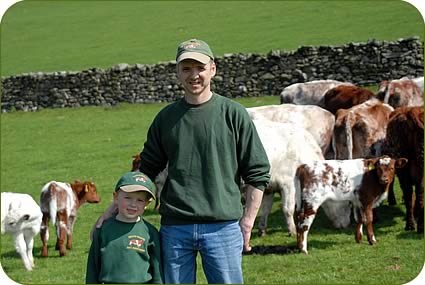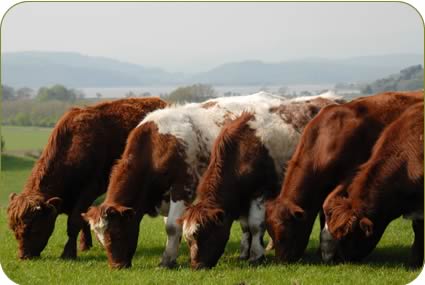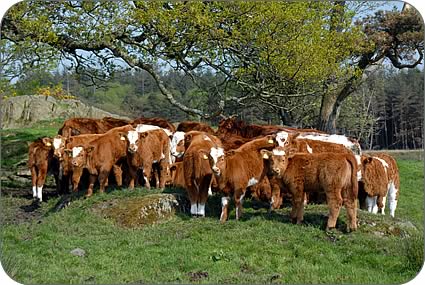Jennifer MacKenzie is an agricultural photo journalist with almost 30 year's experience. Operating from her base in Cumbria, Jennifer undertakes mainly industry-related freelance writing and photography.
Shorthorn is the key to survival
Cumbrian marginal land farmer Tony Wood is convinced that the Beef Shorthorn
is the key to survival since decoupling of agriculture for the family farm.
The family has farmed Abbots Reading, at Haverthwaite, near Ulverston,
for 48 years and for the majority of that time there has been a suckler
herd but it was Shorthorns that caught the eye of Tony and his late father
Derek in 1994.
 |
| Tony Wood and his four year old son
Jake with pure Beef Shorthorn cows and five to six week old calves at Abbots Reading. |
Now with more than 12 years’ experience of the commercial attributes
of the breed, Tony believes the cattle have a solid future post CAP reform.
“I’m confident that if I can make a living with any beef breed
it is with the Shorthorn, a traditional breed noted for its grazing ability
particularly on marginal land and its ease of management in terms of input,
handling and calving,” said Tony.
“In 1995 we were farming 150 acres and we had a bigger sheep flock.
I wanted a breed which enabled me to keep my own replacements and one which
had exceptional eating qualities – the Shorthorn is renowned for
its marbling of meat with two of the best saturated fats which there are
for a balanced diet.
“We saw how good the breed was at the Biggar family’s Chapelton
herd near Castle Douglas in 1994 and invested in some foundation heifers
the following year, even though we were in the heart of continental cattle
country.”
Over the next decade the Woods began marketing their own Shorthorn beef,
having it slaughtered at the local abattoir Aireys Butchers selling mixed
freezer packs and to a local restaurant.
From small beginnings of selling four animals in the first year they direct
marketed 56 in 2005 when the system had to come to an end with Derek’s
untimely death and Tony had to re-think the farming operation.
As the business had grown, more land was taken on – renting 150 acres
at Mearness from Lord Cavendish’s Holker Estates. All the land is
in the Lake District Environmentally Sensitive Area.
Working closely with the estate, pure bred bullocks are now run on the
deer parks and finished at 24 to 28 months old for sale through the estate
food hall alongside the famed Holker saltmarsh lamb. Last year the top
weight off grass was 402kg deadweight.
 |
| Pure bred steers finishing on grass deer parks on the Holker Estate |
A total of 80 animals go to the bull this year – 34 pure bred Shorthorns
and six Highland cross Shorthorns are put to the Shorthorn bull with the
remaining crossbred cows going to the Simmental.
“I used to run two Shorthorn bulls but I run one now alongside the
Simmental which gives me options for marketing the cattle.
“The Simmental was chosen for its temperament, milking ability and
ease of calving. It just seems to click with my cross-bred cattle.
“I have concentrated on getting my commercial cows right. I had some
Highland cows which were crossed with the Shorthorn and I kept a batch
of those heifers to put back to the Shorthorn, keeping the three quarter
bred females.
“These cattle were bred to live outside and we used to outwinter
40, however cross compliance now means we have to house them at Mearness.
“They are just a marvellous cow – they are cheap to keep and
healthy and they can be put to any bull. It’s all about cost and
trying to run a low input system.
“We tried other cross bred continentals and we found when outwintering
the cows that we were using three to four bales of silage less per week
for the Shorthorn cattle than the other batches of continental cross cows.”
Tony stresses the importance of ease of management from calving to handling
of the Shorthorn and Shorthorn cross cattle as he has help from his mother
Carol and other family members. Tony’s partner Sharon is a teacher
and they have a four year old son, Jake and a baby daughter Molly.
Another testament to the Shorthorn’s ease of management and excellent
temperament is that the steers on the deer parks are looked after on a
day-to-day basis by the estate’s maintenance manager Graham Dobson
who had no previous experience of cattle.
Longevity and fertility are other attributes of the pure and cross-bred
dams, says Tony.
 |
| Simmental cross calves at Abbots Reading at five to six weeks old |
The cross-bred cows calve to the Simmental in March and April with calves
introduced to creep feed in July in preparation for sale as suckled calves
in October at seven months old with the first batch of Simmental bull calves
from the crossbreds averaging £425 off their mothers in last autumn’s
trade post the foot and mouth restrictions.
The pure bred cows calve from March to May but now Tony is aiming to tighten
the calving period with the new system and for the first time Shorthorn
calves will be fed creep.
The cattle are turned out in March in batches of about a dozen animals
and are fed big bale silage ad lib and mineral blocks with around 1.5 kg
of concentrate until the grass starts growing in May.
The pure bred bullocks are housed for the first winter, outwintered for
the second on silage and blocks at the deer parks and finished on grass
the following summer while pure-bred heifers not retained as replacements
are sold in Carlisle at two years old as bulling heifers. Run commercially
they have topped at 1,200gns
The cattle are run on an extensive grazing system with the minimum of fertiliser.
Sheep numbers have been cut back to 75 ewes, which are Herdwicks and Herdwick
crosses originally to complement the traditional beef marketing, to free
up the ground for the cattle and extend the season.
Now that he feels his commercial cattle are in line with what he wants,
Tony is now concentrating on his pedigree herd.
Foundation cows were purchased from Glenisla, Fingask and Loch Awe in 1996
and since then Marfen, Tofts, and Glenariff bulls have been used, two of
which have been sold on and are still in use in other herds in their teens.
However, at the 2008 Perth February bull sales, Tony invested 8,000gns
in the Beef Shorthorn champion – Chapelton Zodiac.
“I felt we have a few decent cows that can justify the expense. I
look for an excellent top line and Zodiac’s is like a billiard table!
He has power and length and will put some size into my cows, although I
am not a believer in big cattle. On top of that he has a very a good beef
value and will hopefully keep milk in the herd.
“I’ve got a ten year plan to continue to improve on my pure
and cross bred cattle by which time Jake will probably be old enough to
decide if he wants to farm.
“I’m confident that my heifers, both pure and crossbreds, are
going to be a marketable product.
“Now that the pure herd is at this stage I will be keeping a bull
each year but I have no great expectations about selling breeding bulls – it’s
the heifers where I feel the potential is.”

